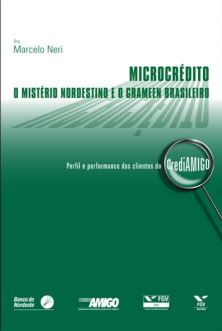
Microcredit: The Northeast Mystery and the Brazilian Grameen - Marcelo Neri
Abstract:
To say that the poor cannot take loans because they do not have collateral is the same as saying that man cannot fly because he has no wings." - Muhammad Yunus, Founder of Grameen Bank and 2006 Nobel Peace Laureate
Productive credit made widely available to the masses frees up the entrepreneurial spirit of low income populations. Anyone who wants to see large scale, profitable, and - better yet - sustainably managed micro-credit in action need not embark upon an exotic adventure. Just visit CrediAmigo. Although the program is little known to most Brazilians, even among policy makers, it rates as one of the best microlending initiatives worldwide, ranks second in number of customers in the Americas, and was recently elected the best microcredit initiative on the continent by MIXMarket, a major microfinance rating agency. CrediAmigo is linked to a federally owned bank, the Banco do Nordeste, and along the lines of Grameen Bank operates on a system of group solidarity, whereby communities put up collateral for loans instead of individuals. It supplies 60% of Brazil's microcredit and reports consistent profits that have increased on the order of 13 percent a year. Its customer base is built solidly on the bottom tiers of Brazil's social pyramid: informal enterprises including grocery stores, corner bars and even private schools. Most importantly, CrediAmigo is helping transform society. The probability that a borrower will rise out of poverty within 12 months of receiving a loan is 60%, while the chances of clients sliding into poverty are only 2%. And no one is getting a subsidy. The program generates profits of 50 reais (around $29) per year per client. Constant reinvention is a fundamental trend in microcredit. Grameen Bank itself went by the name of the Grameen Bank Experiment during its embryonic stage starting in 1977. The bank's founder, Muhammad Yunus, compares that initial phase to the Wright brothers' maiden flight in 1903.
In 2007, I had the opportunity to meet Wilbur Wright, who runs microcredit operations in Peru and Ecuador for the Inter-American Foundation, and also happens to be the homonymous great-grandson of the famed aviation pioneer. "I heard you're a descendant of the inventor of the airplane," I told him when we met. "Yes, I am," he responded, with pride. "I never knew Santos Dumont had flown that far," I teased him, a playful reference to Alberto Santos Dumont, the man we Brazilians know as the Father of Aviation (He flew the 14-Bis, a self-propelled airplane in 1906, while the Wright Brothers needed a catapult to launch the Wright Flyer at Kitty Hawk. But that's a matter for another article.) Santos Dumont's flight, aboard a self-propelled aircraft, is more in line with the idea of microcredit sustainability. Ceape, one of the first microcredit schemes in the developing world, started in 1972 in Pernambuco, in Brazil's Northeast, making it as a sort of the 14-Bis of microcredit. Launching new inventions is important, but making sure they spread and stay aloft over time is even more so. CrediAmigo's advantage lies in its capacity for mass replication. Just as Brazilian aircraft maker Embraer tapped the best spirit of the public sector and went on to soar in private hands, CrediAmigo has parlayed the strengths of both the government and the market into a winning formula. While Grameen Bank opens a branch in New York, CrediAmigo has been exported to Rio de Janeiro, so inverting the received wisdom that technology flows from the modern metropolis to the underdeveloped regions. The Brazilian Northeast bears a strong resemblance to Muhammad Yunus' Bangladesh, with a large population of the working poor most of whom must make ends meet in the informal economy. What is needed now is to take microcredit where it has never gone before, to the very poorest strata of society, without losing its way. CrediAmigo engages the productive sector in low-income cities through a network of credit agents motivated by market incentives. The fact that it never loses sight of the best international practices of alternative collateral mechanisms makes it uniquely capable of addressing poverty while also reaping high returns, and so guarantee its sustainability. The recent crisis in private sector microfinance in India, that so closely mirrors the subprime credit bubble that touched off the global financial collapse of 2008, will only serve to validate the public-private hybrid model employed by CrediAmigo. The beauty of microcredit is that it allows even the smallest entrepreneur to set sail in search of a better life. The poor should not be protected from markets; on the contrary, we should implement policies that offer them the tools and resources necessary to tap the market and prosper by it. Good microcredit does exactly that, avoiding the crippling rates of moneylenders without resorting to the crutch of market distorting subsidies. Fittingly, the most ferocious of marine predators inspire the moniker for the most unscrupulous fauna of finance: loan sharks. It's equally fitting that many microlenders have chosen to associate their brand with the sun, the universal symbol of solidarity. Banco Sol is Bolivia's large microcredit bank.
But especially in a post-crisis world, the best compass for micro lenders is neither the sun nor the sea, but the sage advice Daedalus gave to his eager son, Icarus. Fly strong and high enough to avoid the sea's crashing waves that would drench your wings but not so high as to melt the wax that hold the feathers together.
Number of pages: 375
Index of the book
Chapter 1 – Microcredit: theory and practice
Chapter 2 – Empirical Methodology
Chapter 3 – Nano-entrepreneurs Portrait in Urban Northeast
Chapter 4 – Microcredit Determinants, guarantees and the mystery of capital
Chapter 5 – The Mystery of the Northeast
Chapter 6 – Microcredit and microentrepreneur performance
Chapter 7 – CrediAmigo: tupiniquim Grameen Bank
Chapter 8 – Additional Conditionalities for poverty alleviation: CrediAmigo’s clients case
Chapter 9 – Nanocredit and poverty alleviation
Chapter 10 – Personal Credit
Chapter 11 – Other financial modalities




